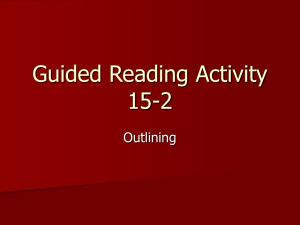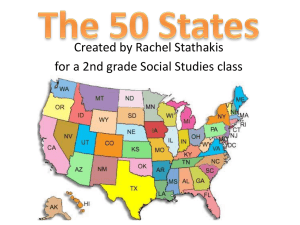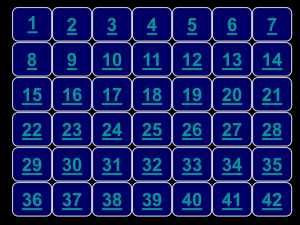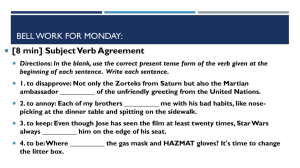Presentation
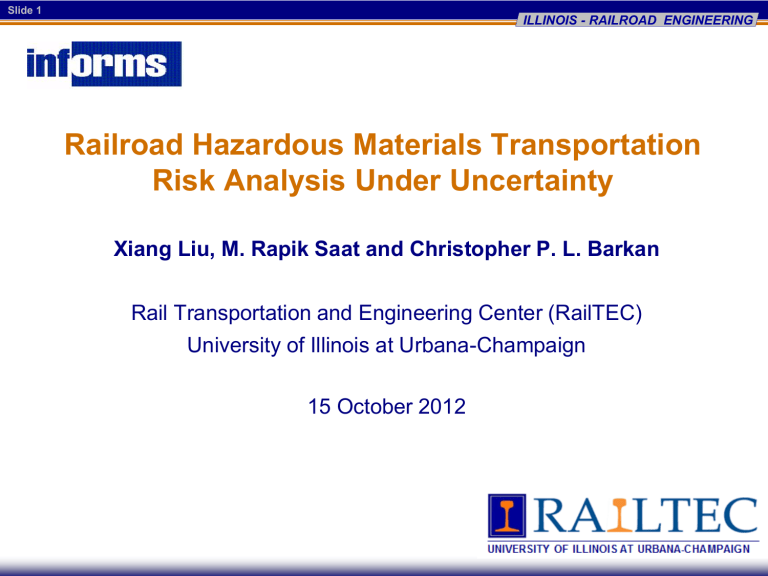
Slide 1
ILLINOIS - RAILROAD ENGINEERING
Railroad Hazardous Materials Transportation
Risk Analysis Under Uncertainty
Xiang Liu, M. Rapik Saat and Christopher P. L. Barkan
Rail Transportation and Engineering Center (RailTEC)
University of Illinois at Urbana-Champaign
15 October 2012
Slide 2
ILLINOIS - RAILROAD ENGINEERING
Outline
• Introduction
– Overview of railroad hazmat transportation
– Events leading to a hazmat release incident
• Uncertainties in the risk assessment
– Standard error of parameter estimation
• Hazmat release rate under uncertainty
• Risk comparison
Slide 3
ILLINOIS - RAILROAD ENGINEERING
Overview of railroad hazardous materials transportation
• There were 1.7 million rail carloads of hazardous materials
(hazmat) in the U.S. in
2010 (AAR, 2011)
• Hazmat traffic account for a small proportion of total rail carloads, but its safety have been placed a high priority
Slide 4
ILLINOIS - RAILROAD ENGINEERING
Chain of events leading to hazmat car release
Hazmat Release Risk = Frequency × Consequence
Accident Cause
Track defect
Equipment defect
Human error
Other
This study focuses on hazmat release frequency
Train is involved in a derailment
Number of cars derailed
Derailed cars contain hazmat
Hazmat car releases contents
Release consequences
Influencing
Factors
• track quality
• method of operation
• track type
• speed
• accident cause
• human factors
• equipment design
• railroad type
• traffic exposure etc.
• train length etc.
• number of hazmat cars in the train
• train length
• placement of hazmat car in the train etc.
• hazmat car safety design
• speed, etc.
• chemical property
• population density
• spill size
• environment etc.
Slide 5
ILLINOIS - RAILROAD ENGINEERING
Modeling hazmat car release rate
Where:
P (R) = release rate (number of hazmat cars released per train-mile, car-mile or gross ton-miles)
P (A)
P(D i
| A)
= derailment rate (number of derailments per train-mile, car-mile or gross ton-mile)
= conditional probability of derailment for a car in i th position of a train
P (H ij
| D i
, A) = conditional probability that the derailed i th car is a type j hazmat car
P (R ij
| H ij
, D i
, A) = conditional probability that the derailed type j hazmat car in i th position of a train released
L
J
= train length
= type of hazmat car
Slide 6
Types of uncertainty
ILLINOIS - RAILROAD ENGINEERING
• Aleatory uncertainty (also called stochastic, type A, irreducible or variability)
– inherent variation associated with a phenomenon or process (e.g., accident occurrence, quantum mechanics etc.)
• Epistemic uncertainty
(also called subjective, type B, reducible and state of knowledge)
– due to lack of knowledge of the system or the environment (e.g., uncertainties in variable, model formulation or decision)
Slide 7
ILLINOIS - RAILROAD ENGINEERING
Comparison of two uncertainties
Population f(x; θ)
Aleatory uncertainty
(stochastic uncertainty)
Sample
(x
1
,..,x n
θ*
)
Epistemic uncertainty
(Statistical uncertainty)
Slide 8
ILLINOIS - RAILROAD ENGINEERING
Uncertainties in hazmat risk assessment
• The evaluation of hazmat release risk is dependent on a number of parameters, such as
– train derailment rate
– car derailment probability
– conditional probability of release etc.
• The true value of each parameter is unknown and could be estimated based on sample data
• The difference between the estimated parameter and the true value of the parameter is measured by standard error
Slide 9
ILLINOIS - RAILROAD ENGINEERING
Standard error of a parameter estimate
• The true value of a parameter is θ. Its estimator is θ*
• Assuming that there are K data samples (each sample contains a group of observations). Each sample has a samplespecific estimator θ k
*
• According to Central Limit Theorem (CLT), θ
1
*,…, θ k
* follow approximately a normal distribution with the mean θ and standard deviation Std( θ*)
– E(θ*) = θ (true value of a parameter)
– Std(θ*) = standard error
θ
1
* θ k
* θ θ
2
*
Slide 10
ILLINOIS - RAILROAD ENGINEERING
Confidence interval of a parameter estimate
95% Confidence Interval
θ* + 1.96Std(θ*)
θ
θ*
θ
θ
θ*-1.96Std(θ*)
Slide 11
ILLINOIS - RAILROAD ENGINEERING
95% confidence interval of train derailment rate
1.8
1.6
1.4
1.2
1.0
0.8
0.6
0.4
0.2
0.0
<20 MGT and Non-Signaled
≥20 MGT and Non-Signaled
<20 MGT and Signaled
≥20 MGT and Signaled
Class 1 Class 2 Class 3
FRA Track Class
Class 4 Class 5
Slide 12
ILLINOIS - RAILROAD ENGINEERING
95% confidence interval of car derailment probability
0.20
0.18
0.16
0.14
0.12
0.10
0.08
0.06
0.04
0.02
0.00
0 20
Upper 95%
Mean
Lower 95%
40 60
Position in Train
80 100
Slide 13
0,06
0,04
0,02
0,00
ILLINOIS - RAILROAD ENGINEERING
95% confidence interval of conditional probability of release
0,10
0,08
105J300W
Tank Car Type
105J600W
Slide 14
ILLINOIS - RAILROAD ENGINEERING
Standard error of risk estimates
• Previous research focused on the single-point risk estimation
• This research analyzes the uncertainty (standard error) of risk estimate
Slide 15
ILLINOIS - RAILROAD ENGINEERING
Numerical Example
The objective is to estimate hazmat release rate (number of cars released per traffic exposure) based on track-related and train-related characteristics
• Track characteristics:
– FRA track class 3
– Non-signaled
– Annual traffic density below 20MGT
• Train characteristics
– Two locomotives and 60 cars
– Train speed 40 mph
– One tank car in the train position most likely to derail
(105J300W)
Slide 16
ILLINOIS - RAILROAD ENGINEERING
Hazmat release rate under uncertainty
Hazmat release rate = train derailment rate × car derailment probability
× conditional probability of release
Estimate
Standard Error
Train Derailment
Rate per Billion
Gross Ton-Miles
0.34
0.026
Car Derailment
Probability
0.165
0.008
Conditional of
Release
0.084
0.005
95% Confidence Interval (0.295,0.395) (0.1496,0.1797) (0.0742,0.0930)
If X
,
Y, Z are mutually independent
( )
E X )
E Y
E Z
0.0047
= 0.34 × 0.165 × 0.084
(0.026 cars released per million train-miles)
Slide 17
ILLINOIS - RAILROAD ENGINEERING
Standard error of risk estimate
If X i are mutually independent
Estimate
Standard Error
Train Derailment
Rate per Billion
Gross Ton-Miles
0.34
0.026
Car Derailment
Probability
0.165
0.008
Conditional of
Release
0.084
0.005
Hazmat Release
Rate per Billon
Gross Ton-Miles
0.0047
0.000496
95% Confidence Interval (0.295,0.395) (0.1496,0.1797) (0.0742,0.0930) (0.0037,0.0057)
Source: Goodman, L.A. (1962). The variance of the product of K random variables.
Journal of the American Statistical Association. Vol. 57, No. 297, pp. 54-60.
Slide 18
ILLINOIS - RAILROAD ENGINEERING
Route-specific hazmat release risk
Segment 1 Segment 2 Segment n
R
1
Std(R
1
)
R
2
Std(R
2
)
R n
Std(R n
)
• Route-specific risk
– Estimate = R
1
+ R
2
+ … + R n
– Standard error = 2 2
Std(R ) +Std(R ) +...+Std(R )
1 2 n
2
Slide 19
ILLINOIS - RAILROAD ENGINEERING
Risk comparison under uncertainty
• The uncertainty in the risk assessment should be taken into account to compare different risks
• For example, assuming a baseline route has estimated risk 0.3, an alternative route has estimated risk 0.5, is this difference large enough to conclude that the two routes have different safety performance?
– It depends on the standard error of risk estimate on each route
Slide 20
ILLINOIS - RAILROAD ENGINEERING
A statistical test for risk difference
• There are two hazmat routes, whose mean risk estimates and standard errors are (R
1
,S
1
) and (R
2
, S
2
), respectively.
Conclusion Z-Test
R
1
R
2 s
1
2 s
2
2
z a / 2
Hypothesis
H o
: µ
1
H a
: µ
1
= µ
2
≠ µ
2
The two routes have different risks
R
1
R
2 s
1
2 s
2
2
z a
R
1
R
2 s
1
2 s
2
2
z a
H o
: µ
1
H a
: µ
1
= µ
2
> µ
2
H o
: µ
1
H a
: µ
1
= µ
2
< µ
2
Route 1 has a higher risk
Route 1 has a lower risk
Slide 21
ILLINOIS - RAILROAD ENGINEERING
Conclusions
• Risk analysis of railroad hazmat transportation is subject to uncertainty due to statistical inference based on sample data
• These uncertainties affect the reliability of risk estimate and corresponding decision making
• In addition to single-point risk estimate, its standard error and confidence interval should also be quantified and incorporated into the safety management
Slide 22
ILLINOIS - RAILROAD ENGINEERING
Thank You!
Xiang (Shawn) Liu
Ph.D. Candidate
Rail Transportation and Engineering Center (RailTEC)
Department of Civil and Environmental Engineering
University of Illinois at Urbana-Champaign
Office:(217) 244-6063
Email: liu94@illinois.edu
Rail Transportation and Engineering Center (RailTEC) http://ict.illinois.edu/railroad

